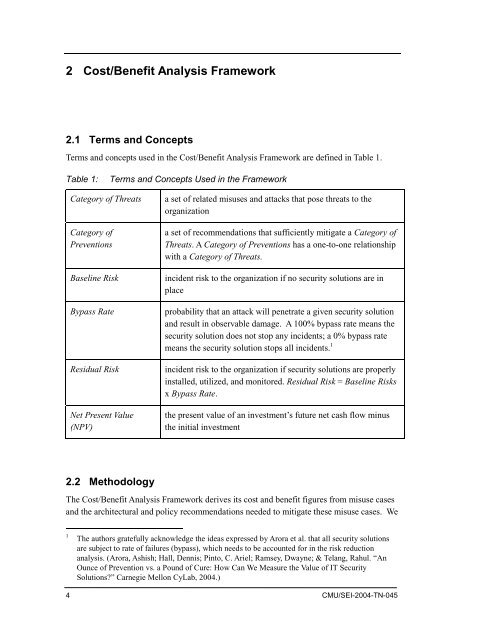SQUARE Project: Cost/Benefit Analysis Framework for Information ...
SQUARE Project: Cost/Benefit Analysis Framework for Information ...
SQUARE Project: Cost/Benefit Analysis Framework for Information ...
Create successful ePaper yourself
Turn your PDF publications into a flip-book with our unique Google optimized e-Paper software.
2 <strong>Cost</strong>/<strong>Benefit</strong> <strong>Analysis</strong> <strong>Framework</strong><br />
2.1 Terms and Concepts<br />
Terms and concepts used in the <strong>Cost</strong>/<strong>Benefit</strong> <strong>Analysis</strong> <strong>Framework</strong> are defined in Table 1.<br />
Table 1:<br />
Terms and Concepts Used in the <strong>Framework</strong><br />
Category of Threats<br />
Category of<br />
Preventions<br />
Baseline Risk<br />
Bypass Rate<br />
Residual Risk<br />
Net Present Value<br />
(NPV)<br />
a set of related misuses and attacks that pose threats to the<br />
organization<br />
a set of recommendations that sufficiently mitigate a Category of<br />
Threats. A Category of Preventions has a one-to-one relationship<br />
with a Category of Threats.<br />
incident risk to the organization if no security solutions are in<br />
place<br />
probability that an attack will penetrate a given security solution<br />
and result in observable damage. A 100% bypass rate means the<br />
security solution does not stop any incidents; a 0% bypass rate<br />
means the security solution stops all incidents. 1<br />
incident risk to the organization if security solutions are properly<br />
installed, utilized, and monitored. Residual Risk = Baseline Risks<br />
x Bypass Rate.<br />
the present value of an investment’s future net cash flow minus<br />
the initial investment<br />
2.2 Methodology<br />
The <strong>Cost</strong>/<strong>Benefit</strong> <strong>Analysis</strong> <strong>Framework</strong> derives its cost and benefit figures from misuse cases<br />
and the architectural and policy recommendations needed to mitigate these misuse cases. We<br />
1<br />
The authors gratefully acknowledge the ideas expressed by Arora et al. that all security solutions<br />
are subject to rate of failures (bypass), which needs to be accounted <strong>for</strong> in the risk reduction<br />
analysis. (Arora, Ashish; Hall, Dennis; Pinto, C. Ariel; Ramsey, Dwayne; & Telang, Rahul. “An<br />
Ounce of Prevention vs. a Pound of Cure: How Can We Measure the Value of IT Security<br />
Solutions?” Carnegie Mellon CyLab, 2004.)<br />
4 CMU/SEI-2004-TN-045
















